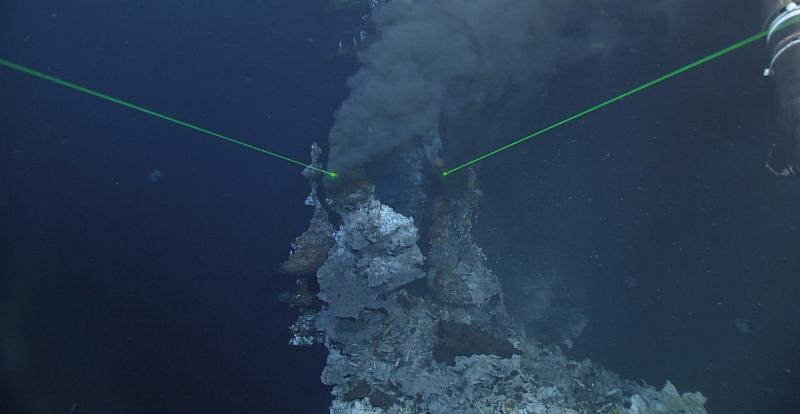Marine biology research at IOCAS also extends to the deep sea, whose extreme environment hosts unique life forms and bio-resources. To go deeper, view clearly, and collect more samples, demands advanced technologies. Drawing on the capabilities of a 4,700-tonne maritime research vessel, Kexue, the first of its kind in China, IOCAS has built a systematic platform, incorporating a remotely operated vehicle (ROV), Faxian, capable of working 4,500 metres under water, and other advanced equipment for submarine and extreme environment inspections. This enables comprehensive investigation of previously unchartered territories, including seamounts, hydrothermal vents, and cold seeps, which are regarded as the most likely places to find clues to life's origins.

The ROV designed by IOCAS enables sampling and detection 4,500 metres under water, allowing comprehensive investigation of cold seeps and hydrothermal vents. (Image by IOCAS)
To explore the habitability of the Earth and the origins of life, IOCAS's Center for Deep Sea Research studies deep-sea carbon and oxygen recycling. Using a specially developed in-situ Raman insertion probe (RiP) system, researchers found supercritical CO2, a fluid state of CO2 from the Earth’s early history, and identified unique Raman peaks. Based on the finding, they proposed that the interface between atmosphere and hydrosphere was the best place for the formation of amino acids.
Based on geochemical analyses of rock samples from the South China Sea, the centre’s researchers were the first to identify natural carbonated silicate melts, which were found to be transformed to alkali basalts through reactions with the lithospheric mantle. The study offers a new mechanism for explaining the wide distribution of alkali basalts, and suggests that a thin lithosphere facilitates the release of CO2 stored deep within Earth's mantle.
Using geochemical data from rocks associated with volcanic arcs, IOCAS researchers found dramatic decreases of thorium-uranium ratios in arc rocks that occurred in line with the onset of the Great Oxidation Event and the Neoproterozoic Oxygenation Event, two periods that experienced significant rises in atmospheric oxygen. This shows the effectiveness of using igneous geochemistry to determine the timing of atmospheric oxygenation events.
Deep-sea exploration is also a national strategic goal, for its essential role in preserving biodiversity and ecological health, enshrined by international agreements.
At IOCAS's Laboratory of Marine Organism Taxonomy & Phylogeny (MOTP) Studies, a pioneer in surveys on marine biodiversity, researchers have explored nine seamounts in the tropical Western Pacific, hydrothermal fluids from Manus Basin, and the South China Sea cold seeps for biodiversity research.
As China's largest deep-sea sampling activity with the most diverse samples to date, it led to the discovery of two new families, one new subfamily, three new genera, and more than 100 new species. A bio sample bank has been established, including 6,000 massive and large-size bio samples, covering 600-plus deep-sea species. More than 8,000 bacterial strains were isolated and cultured, and 46 new bacterial species were discovered. The study has enriched our understanding of deep-sea biodiversity.
In the deep-sea environment, seamounts, home to diverse biomes, are valuable ecosystems for biodiversity studies, yet, are inadequately investigated. IOCAS’s biodiversity analysis of three adjacent seamounts in the Western Pacific showed that of the species found at the seamounts, less than 5% were found at all three. This illustrates the uniqueness of species in each seamount, and the low connectivity between them, emphasizing the value of protecting biodiversity. It also provides the basis for studying geographic distribution and connectivity of deep-sea organisms.
IOCAS's deep-sea explorations also inspired fundamental research into the adaptive strategies and evolutionary histories of marine organisms and the origin of life. Particular attention was devoted to scale worms (Polynoidae), a shrimp family (Alvinocarididae), and deep-sea mussels (Bathymodiolinae), all of which were found to have the highest biodiversity in the Western Pacific. Based on this finding, IOCAS researchers proposed that hydrothermal areas in the Western Pacific could be the origin of Polynoidae. Molecular development studies on Alvinocarididae suggested an evolutionary model from shallow sea, to deep sea, and then hydrothermal vents for this species, highlighting the key role of Western Pacific hydrothermal areas in the evolution histories and distributions of deep-sea organisms. Comprehensive studies on deep-sea mussels underlie how they interact with their symbionts to survive in the vents and/or cold seeps. A dynamic model was proposed to highlight the crucial roles of lysosome and innate immune systems in the host-symbiont interactions.

